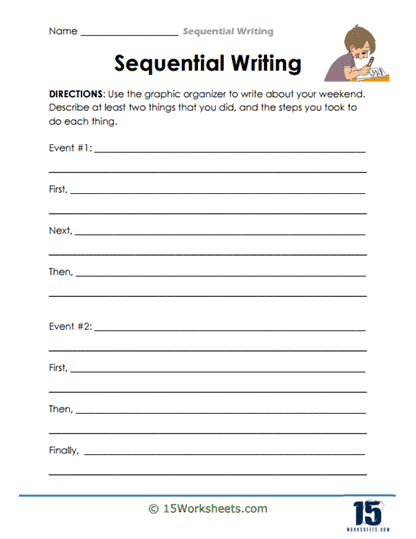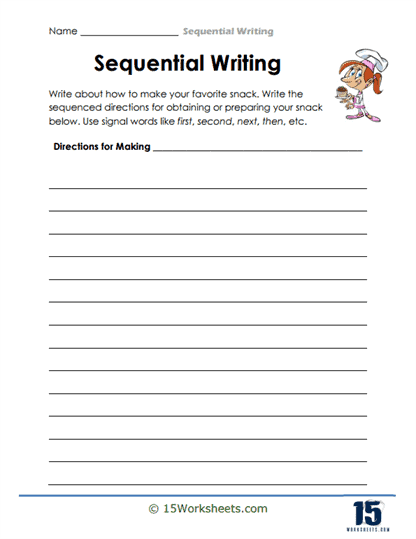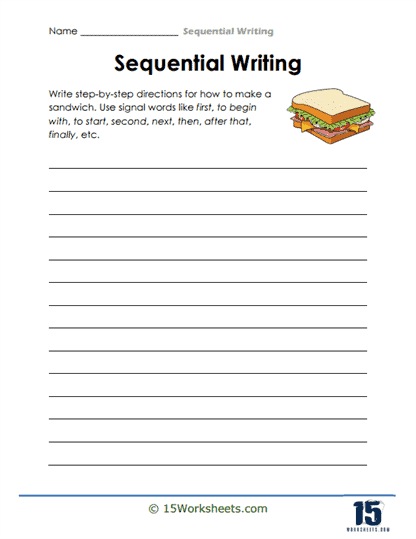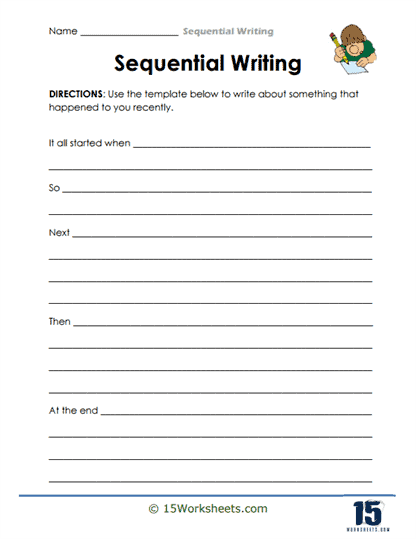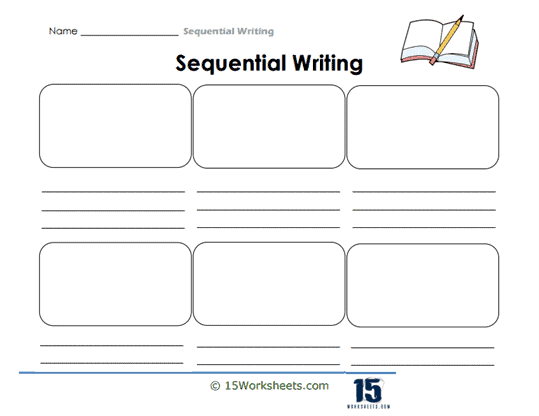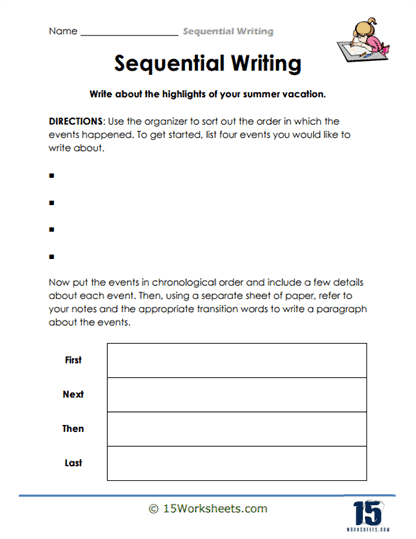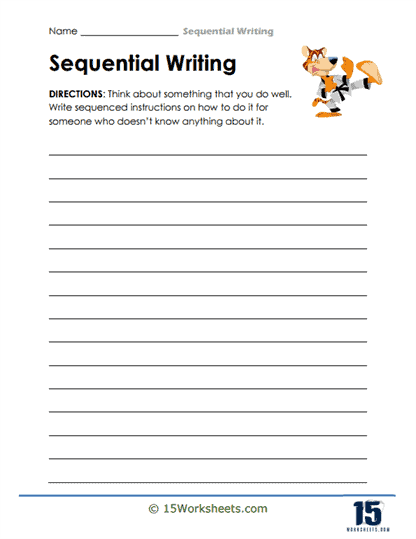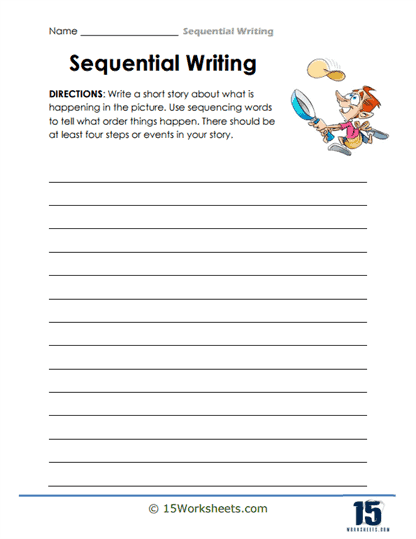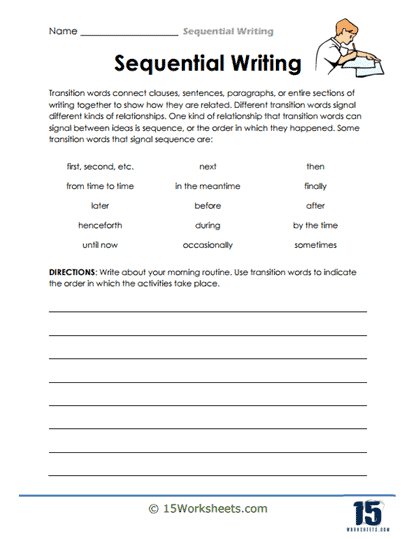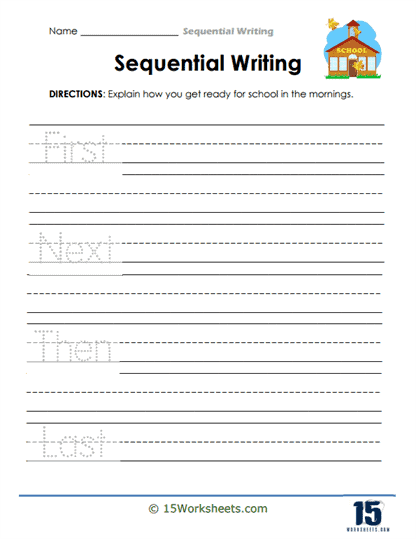Sequential Writing Worksheets
About These 15 Worksheets
This series is designed to enhance students’ ability to organize thoughts and information in a logical, sequential manner. These worksheets cater to a range of ages and skill levels, focusing on the development of narrative skills, understanding of chronological order, and the ability to explain processes or events step-by-step. Through a variety of exercises, Sequential Writing Worksheets not only bolster writing proficiency but also sharpen critical thinking and reasoning abilities. Let’s explore the types of exercises these worksheets include and how they contribute to students’ development.
These worksheets are powerful tools in developing students’ writing and reasoning skills. Through a diverse array of exercises, these worksheets encourage students to think critically and logically, organize their thoughts coherently, and express themselves clearly. The skills honed by regularly engaging with these worksheets-organizational ability, narrative competence, understanding of temporal relationships, and the ability to communicate instructions-are fundamental not only to academic success but also to effective communication in daily life. As students become more proficient in sequencing their thoughts and writing, they lay the groundwork for more advanced analytical, writing, and reasoning tasks, setting them up for a lifetime of clear thinking and effective communication.
Types of Exercises
1. Story Sequencing
Students are given sentences or paragraphs that narrate a story out of order. Their task is to rearrange these elements into a coherent narrative that makes sense from beginning to end. This exercise teaches the importance of narrative flow and the foundational structure of storytelling.
2. Process Writing
These exercises ask students to describe a process, such as how to make a sandwich or how a plant grows, in the correct sequence. This not only helps in understanding logical order but also in using transitional words and phrases that indicate sequence (first, next, then, finally).
3. Before and After
Students are presented with scenarios or pictures and are asked to write about the events that led up to the scenario (before) and what might happen next (after). This encourages thinking in terms of cause and effect, a crucial component of logical reasoning.
4. Fill in the Blanks
Worksheets may contain stories or processes with missing steps. Students must fill in these blanks to complete the sequence logically. This exercise enhances problem-solving skills and the ability to deduce missing information based on context.
5. Creating Timelines
Students might be asked to create timelines of historical events, scientific discoveries, or personal experiences. This visual representation of sequence helps in understanding temporal relationships and the importance of chronological order.
6. Comic Strip Ordering
Comic strips or picture stories are provided out of order, and students must rearrange them to tell the story correctly. This exercise is particularly engaging and helps students understand narrative sequencing visually and textually.
7. Instructional Writing
Students are tasked with writing instructions for simple activities or games, focusing on clarity and the logical sequence of steps. This type of exercise is practical, as it relates directly to real-life tasks and emphasizes the importance of clear, sequential communication.
Impact on Writing and Reasoning Skills
Practicing with Sequential Writing Worksheets offers numerous benefits to students’ writing and reasoning skills:
1. Enhanced Organizational Skills
By engaging in exercises that require logical ordering, students learn to structure their thoughts and writings in a more organized manner. This skill is vital in all forms of writing, from creative stories to academic essays.
2. Improved Clarity and Cohesion
Learning to write sequences clearly and cohesively helps students convey their ideas more effectively. The use of transitional phrases and the ability to maintain a logical flow make their writing more understandable and engaging.
3. Critical Thinking Development
Determining the correct sequence of events or steps in a process requires critical thinking. Students must evaluate information, discern relationships between concepts, and apply logic to arrange ideas appropriately, thereby enhancing their reasoning capabilities.
4. Narrative Skills
Story sequencing exercises improve narrative skills, including understanding plot development, character progression, and the use of suspense and climax. These are essential components of effective storytelling and creative writing.
5. Understanding of Temporal Relationships
Exercises that involve timelines or chronological ordering enhance students’ understanding of temporal relationships. This understanding is crucial not just in history or science but in everyday reasoning about cause and effect.
6. Ability to Follow and Give Directions
Instructional writing and process writing exercises improve students’ ability to follow and give clear directions. This skill is invaluable in academic settings, the workplace, and in daily life, where clear, sequential communication is often required.
7. Problem-Solving Skills
Fill-in-the-blank and comic strip ordering exercises enhance problem-solving skills. Students must use context clues and logical reasoning to determine what is missing or what comes next, fostering an analytical approach to information.





